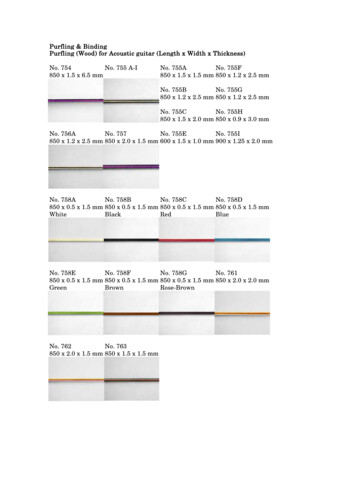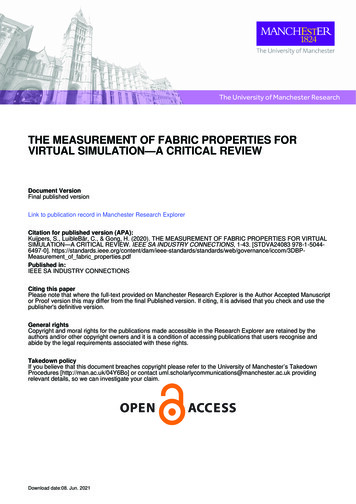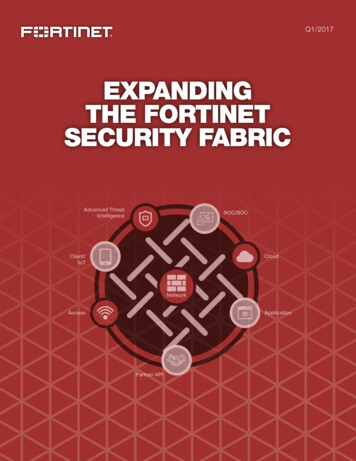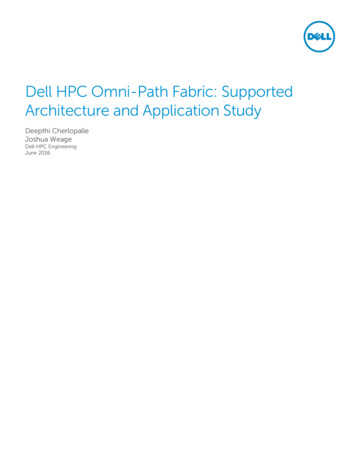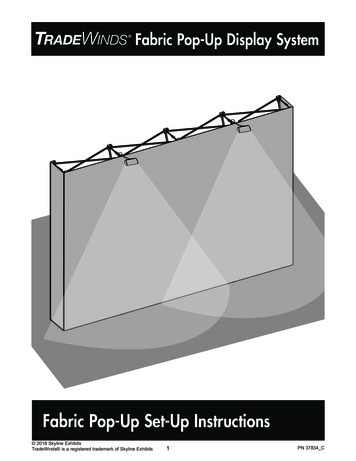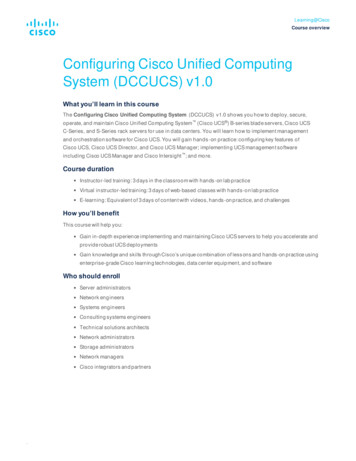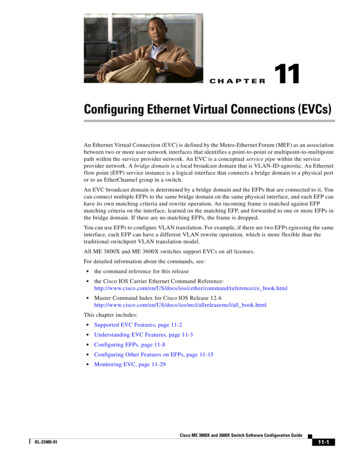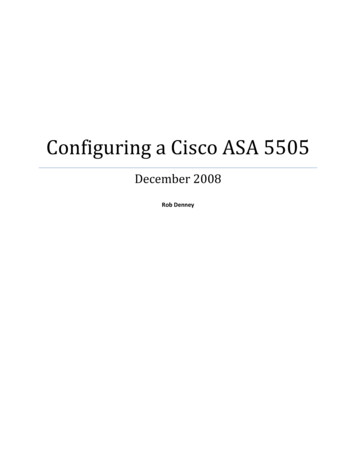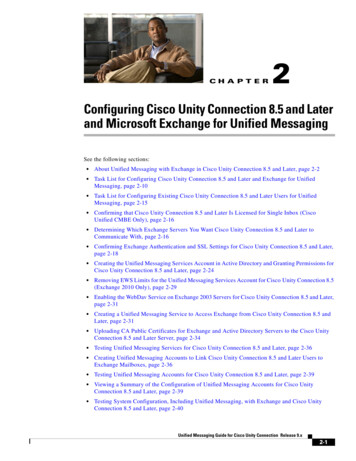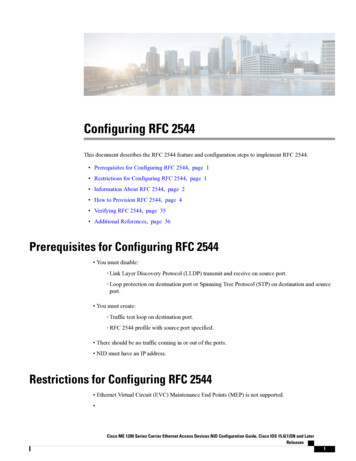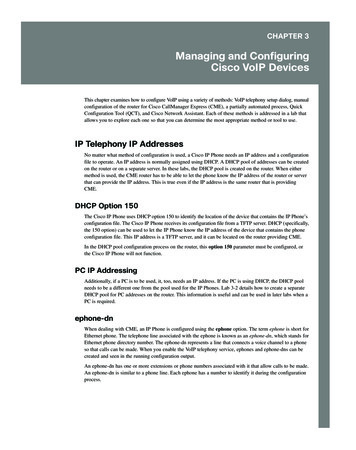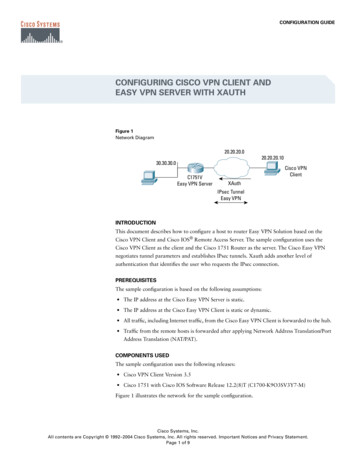
Transcription
CHAPTER11Configuring Fabric BindingThis chapter describes the fabric binding feature provided in the Cisco MDS 9000 Family of directorsand switches. It includes the following sections: About Fabric Binding, page 11-249 Fabric Binding Configuration, page 11-251 Default Settings, page 11-257About Fabric BindingThe fabric binding feature ensures ISLs are only enabled between specified switches in the fabricbinding configuration. Fabric binding is configured on a per-VSAN basis.This feature helps prevent unauthorized switches from joining the fabric or disrupting current fabricoperations. It uses the Exchange Fabric Membership Data (EFMD) protocol to ensure that the list ofauthorized switches is identical in all switches in the fabric.This section has the following topics: Licensing Requirements, page 11-249 Port Security Versus Fabric Binding, page 11-249 Fabric Binding Enforcement, page 11-250Licensing RequirementsFabric binding requires that you install either the MAINFRAME PKG license or theENTERPRISE PKG license on your switch.See the Cisco MDS 9000 Family NX-OS Licensing Guide for more information on license feature supportand installation.Port Security Versus Fabric BindingPort security and fabric binding are two independent features that can be configured to complement eachother. Table 11-1 compares the two features.Cisco MDS 9000 Family NX-OS Security Configuration Guide11-249
Chapter 11Configuring Fabric BindingAbout Fabric BindingTable 11-1Fabric Binding and Port Security ComparisonFabric BindingPort SecurityUses a set of sWWNs and a persistent domainID.Uses pWWNs/nWWNs or fWWNs/sWWNs.Binds the fabric at the switch level.Binds devices at the interface level.Authorizes only the configured sWWN stored in Allows a preconfigured set of Fibre Channelthe fabric binding database to participate in the devices to logically connect to a SAN ports. Thefabric.switch port, identified by a WWN or interfacenumber, connects to a Fibre Channel device (a hostor another switch), also identified by a WWN. Bybinding these two devices, you lock these two portsinto a group (or list).Requires activation on a per VSAN basis.Requires activation on a per VSAN basis.Allows specific user-defined physical ports toAllows specific user-defined switches that areallowed to connect to the fabric, regardless of the which another device can connect.physical port to which the peer switch isconnected.Does not learn about switches that are logging in. Learns about switches or devices that are logging inif learning mode is enabled.Cannot be distributed by CFS and must beconfigured manually on each switch in thefabric.Can be distributed by CFS.Port-level checking for xE ports is as follows: The switch login uses both port security binding and fabric binding for a given VSAN. Binding checks are performed on the port VSAN as follows:– E port security binding check on port VSAN– TE port security binding check on each allowed VSANWhile port security complements fabric binding, they are independent features and can be enabled ordisabled separately.Fabric Binding EnforcementTo enforce fabric binding, configure the switch world wide name (sWWN) to specify the xE portconnection for each switch. Enforcement of fabric binding policies are done on every activation andwhen the port tries to come up. In a FICON VSAN, the fabric binding feature requires all sWWNsconnected to a switch and their persistent domain IDs to be part of the fabric binding active database. Ina Fibre Channel VSAN, only the sWWN is required; the domain ID is optional.NoteAll switches in a Fibre Channel VSAN using fabric binding must be running Cisco MDS SAN-OSRelease 3.0(1) and NX-OS Release 4.1(1b) or later.Cisco MDS 9000 Family NX-OS Security Configuration Guide11-250
Chapter 11Configuring Fabric BindingFabric Binding ConfigurationFabric Binding ConfigurationTo configure fabric binding in each switch in the fabric, follow these steps:Step 1Enable the fabric configuration feature.Step 2Configure a list of sWWNs and their corresponding domain IDs for devices that are allowed to accessthe fabric.Step 3Activate the fabric binding database.Step 4Copy the fabric binding active database to the fabric binding config database.Step 5Save the fabric binding configuration.Step 6Verify the fabric binding configuration.Enabling Fabric BindingThe fabric binding feature must be enabled in each switch in the fabric that participates in the fabricbinding. By default, this feature is disabled in all switches in the Cisco MDS 9000 Family. Theconfiguration and verification commands for the fabric binding feature are only available when fabricbinding is enabled on a switch. When you disable this configuration, all related configurations areautomatically discarded.To enable fabric binding on any participating switch, follow these steps:CommandPurposeStep 1switch# config tEnters configuration mode.Step 2switch(config)# feature fabric-bindingEnables fabric binding on that switch.switch(config)# no featurefabric-bindingDisables (default) fabric binding on that switch.View the status of the fabric binding feature of a fabric binding-enabled switch by issuing the showfabric-binding status command.switch# show fabric-binding statusVSAN 1:Activated databaseVSAN 4:No Active databaseConfiguring Switch WWN ListA user-specified fabric binding list contains a list of switch WWNs (sWWNs) within a fabric. If ansWWN attempts to join the fabric, and that sWWN is not on the list or the sWWN is using a domain IDthat differs from the one specified in the allowed list, the ISL between the switch and the fabric isautomatically isolated in that VSAN and the switch is denied entry into the fabric.The persistent domain ID can be specified along with the sWWN. Domain ID authorization is requiredin FICON VSANs where the domains are statically configured and the end devices reject a domain IDchange in all switches in the fabric. Domain ID authorization is not required in Fibre Channel VSANs.Cisco MDS 9000 Family NX-OS Security Configuration Guide11-251
Chapter 11Configuring Fabric BindingFabric Binding ConfigurationTo configure a list of sWWNs and domain IDs for a FICON VSAN, follow these steps:CommandPurposeStep 1switch# config tswitch(config)#Enters configuration mode.Step 2switch(config)# fabric-binding database vsan 5switch(config-fabric-binding)#Enters the fabric binding submode for thespecified VSAN.switch(config)# no fabric-binding database vsan5Deletes the fabric binding database for thespecified VSAN.switch(config-fabric-binding)# swwn21:00:05:30:23:11:11:11 domain 102Adds the sWWN and domain ID of a switchto the configured database list.switch(config-fabric-binding)# swwn21:00:05:30:23:1a:11:03 domain 101Adds the sWWN and domain ID of anotherswitch to the configured database list.switch(config-fabric-binding)# no swwn21:00:15:30:23:1a:11:03 domain 101Deletes the sWWN and domain ID of aswitch from the configured database list.switch(config-fabric-binding)# exitswitch(config)#Exits the fabric binding submode.Step 3Step 4To configure a list of sWWNs and optional domain IDs for a Fibre Channel VSAN, follow these steps:CommandPurposeStep 1switch# config tswitch(config)#Enters configuration mode.Step 2switch(config)# fabric-binding database vsan 10switch(config-fabric-binding)#Enters the fabric binding submode for thespecified VSAN.switch(config)# no fabric-binding database vsan10Deletes the fabric binding database for thespecified VSAN.switch(config-fabric-binding)# swwn21:00:05:30:23:11:11:11Adds the sWWN of a switch for all domainsto the configured database list.switch(config-fabric-binding)# no swwn21:00:05:30:23:11:11:11Deletes the sWWN of a switch for alldomains from the configured database list.switch(config-fabric-binding)# swwn21:00:05:30:23:1a:11:03 domain 101Adds the sWWN of another switch for aspecific domain ID to the configureddatabase list.switch(config-fabric-binding)# no swwn21:00:15:30:23:1a:11:03 domain 101Deletes the sWWN and domain ID of aswitch from the configured database list.switch(config-fabric-binding)# exitswitch(config)#Exits the fabric binding submode.Step 3Step 4Fabric Binding ActivationThe fabric binding feature maintains a configuration database (config-database) and an active database.The config-database is a read-write database that collects the configurations you perform. Theseconfigurations are only enforced upon activation. This activation overwrites the active database with thecontents of the config- database. The active database is read-only and is the database that checks eachswitch that attempts to log in.Cisco MDS 9000 Family NX-OS Security Configuration Guide11-252
Chapter 11Configuring Fabric BindingFabric Binding ConfigurationBy default, the fabric binding feature is not activated. You cannot activate the fabric binding database onthe switch if entries existing in the configured database conflict with the current state of the fabric. Forexample, one of the already logged in switches may be denied login by the config-database. You canchoose to forcefully override these situations.NoteAfter activation, any already logged in switch that violates the current active database will be logged out,and all switches that were previously denied login because of fabric binding restrictions are reinitialized.To activate the fabric binding feature, follow these steps:CommandPurposeStep 1switch# config tswitch(config)#Enters configuration mode.Step 2switch(config)# fabric-binding activate vsan 10Activates the fabric binding database forthe specified VSAN.switch(config)# no fabric-binding activate vsan 10Deactivates the fabric binding database forthe specified VSAN.Forcing Fabric Binding ActivationIf the database activation is rejected due to one or more conflicts listed in the previous section, you maydecide to proceed with the activation by using the force option.To forcefully activate the fabric binding database, follow these steps:CommandPurposeStep 1switch# config tswitch(config)#Enters configuration mode.Step 2switch(config)# fabric-binding activate vsan 3 forceActivates the fabric binding databasefor the specified VSANforcefully—even if the configurationis not acceptable.switch(config)# no fabric-binding activate vsan 3 forceReverts to the previously configuredstate or to the factory default (if nostate is configured).Saving Fabric Binding ConfigurationsWhen you save the fabric binding configuration, the config database is saved to the runningconfiguration.CautionYou cannot disable fabric binding in a FICON-enabled VSAN. Use the fabric-binding database copy vsan command to copy from the active database to theconfig database. If the configured database is empty, this command is not accepted.switch# fabric-binding database copy vsan 1Cisco MDS 9000 Family NX-OS Security Configuration Guide11-253
Chapter 11Configuring Fabric BindingFabric Binding Configuration Use the fabric-binding database diff active vsan command to view the differences between theactive database and the config database. This command can be used when resolving conflicts.switch# fabric-binding database diff active vsan 1 Use the fabric-binding database diff config vsan command to obtain information on thedifferences between the config database and the active database.switch# fabric-binding database diff config vsan 1 Use the copy running-config startup-config command to save the running configuration to thestartup configuration so that the fabric binding config database is available after a reboot.switch# copy running-config startup-configClearing the Fabric Binding StatisticsUse the clear fabric-binding statistics command to clear all existing statistics from the fabric bindingdatabase for a specified VSAN.switch# clear fabric-binding statistics vsan 1Deleting the Fabric Binding DatabaseUse the no fabric-binding command in configuration mode to delete the configured database for aspecified VSAN.switch(config)# no fabric-binding database vsan 10Verifying Fabric Binding ConfigurationsUse the show commands to display all fabric binding information configured on this switch (seeExamples 11-1 to 11-9).Example 11-1Displays Configured Fabric Binding Database Informationswitch# show fabric-binding -------VsanLogging-in Switch 0xea(234) 1a:11:03Any420:00:00:05:30:00:2a:1e0xea(234) xea(234) [Local][Total 7 entries]Cisco MDS 9000 Family NX-OS Security Configuration Guide11-254
Chapter 11Configuring Fabric BindingFabric Binding ConfigurationExample 11-2Displays Active Fabric Binding Informationswitch# show fabric-binding database -----VsanLogging-in Switch 0xea(234) xef(239) [Local]Example 11-3Displays Configured VSAN-Specific Fabric Binding Informationswitch# show fabric-binding database vsan VsanLogging-in Switch :23:1a:11:03Any420:00:00:05:30:00:2a:1e0xea(234) [Local][Total 2 entries]Example 11-4Displays Active VSAN-Specific Fabric Binding Informationswitch# show fabric-binding database active vsan -VsanLogging-in Switch :1e0xef(239) [Local][Total 3 entries]Example 11-5Displays Fabric Binding Statisticsswitch# show fabric-binding statisticsStatistics For VSAN: 1-----------------------Number of sWWN permit: 0Number of sWWN deny : 0Total Logins permitted : 0Total Logins denied: 0Statistics For VSAN: 4-----------------------Number of sWWN permit: 0Number of sWWN deny : 0Total Logins permitted : 0Total Logins denied: 0Statistics For VSAN: 61-----------------------Number of sWWN permit: 0Number of sWWN deny : 0Total Logins permittedTotal Logins denied: 0: 0Cisco MDS 9000 Family NX-OS Security Configuration Guide11-255
Chapter 11Configuring Fabric BindingFabric Binding ConfigurationStatistics For VSAN: 345-----------------------Number of sWWN permit: 0Number of sWWN deny : 0Total Logins permitted : 0Total Logins denied: 0Statistics For VSAN: 346-----------------------Number of sWWN permit: 0Number of sWWN deny : 0Total Logins permitted : 0Total Logins denied: 0Statistics For VSAN: 347-----------------------Number of sWWN permit: 0Number of sWWN deny : 0Total Logins permitted : 0Total Logins denied: 0Statistics For VSAN: 348-----------------------Number of sWWN permit: 0Number of sWWN deny : 0Total Logins permitted : 0Total Logins denied: 0Statistics For VSAN: 789-----------------------Number of sWWN permit: 0Number of sWWN deny : 0Total Logins permitted : 0Total Logins denied: 0Statistics For VSAN: 790-----------------------Number of sWWN permit: 0Number of sWWN deny : 0Total Logins permittedTotal Logins deniedExample 11-6: 0: 0Displays Fabric Binding Status for Each VSANswitch# show fabric-binding statusVSAN 1 :Activated databaseVSAN 4 :No Active databaseVSAN 61 :Activated databaseVSAN 345 :No Active databaseVSAN 346 :No Active databaseVSAN 347 :No Active databaseVSAN 348 :No Active databaseVSAN 789 :No Active databaseVSAN 790 :No Active databaseExample 11-7Displays Fabric Binding Violationsswitch# show fabric-binding ---------------------------------------Cisco MDS 9000 Family NX-OS Security Configuration Guide11-256
Chapter 11Configuring Fabric BindingDefault SettingsVSAN Switch WWN [domain]Last-Time[Repeat count] 00:4a:1e [0xeb] Nov 25 05:46:14 2003[2]Domain mismatch320:00:00:05:30:00:4a:1e [*] Nov 25 05:44:58 2003[2]sWWN not found420:00:00:05:30:00:4a:1e [*] Nov 25 05:46:25 2003[1]Database mismatchNoteIn VSAN 3 the sWWN itself was not found in the list. In VSAN 2, the sWWN was found in the list, buthas a domain ID mismatch.Example 11-8Displays EFMD Statisticsswitch# show fabric-binding efmd statisticsEFMD Protocol Statistics for VSAN 1---------------------------------------Merge Requests - Transmitted : 0 , ReceivedMerge Accepts - Transmitted : 0 , ReceivedMerge Rejects - Transmitted : 0 , ReceivedMerge Busy- Transmitted : 0 , ReceivedMerge Errors- Transmitted : 0 , Received:::::00000EFMD Protocol Statistics for VSAN 4---------------------------------------Merge Requests - Transmitted : 0 , ReceivedMerge Accepts - Transmitted : 0 , ReceivedMerge Rejects - Transmitted : 0 , ReceivedMerge Busy- Transmitted : 0 , ReceivedMerge Errors- Transmitted : 0 , Received:::::00000EFMD Protocol Statistics for VSAN 61---------------------------------------Merge Requests - Transmitted : 0 , ReceivedMerge Accepts - Transmitted : 0 , ReceivedMerge Rejects - Transmitted : 0 , ReceivedMerge Busy- Transmitted : 0 , ReceivedMerge Errors- Transmitted : 0 , Received:::::00000Example 11-9Displays EFMD Statistics for a Specified VSANswitch# show fabric-binding efmd statistics vsan 4EFMD Protocol Statistics for VSAN 4---------------------------------------Merge Requests - Transmitted : 0 , ReceivedMerge Accepts - Transmitted : 0 , ReceivedMerge Rejects - Transmitted : 0 , ReceivedMerge Busy- Transmitted : 0 , ReceivedMerge Errors- Transmitted : 0 , Received:::::00000Default SettingsTable 11-2 lists the default settings for the fabric binding feature.Cisco MDS 9000 Family NX-OS Security Configuration Guide11-257
Chapter 11Default SettingsTable 11-2Default Fabric Binding SettingsParametersDefaultFabric bindingDisabledCisco MDS 9000 Family NX-OS Security Configuration Guide11-258Configuring Fabric Binding
The switch login uses both port security binding and fabric binding for a given VSAN. Binding checks are performed on the port VSAN as follows: – E port security binding check on port VSAN – TE port security binding check on each allowed VSAN While port security complements fab
